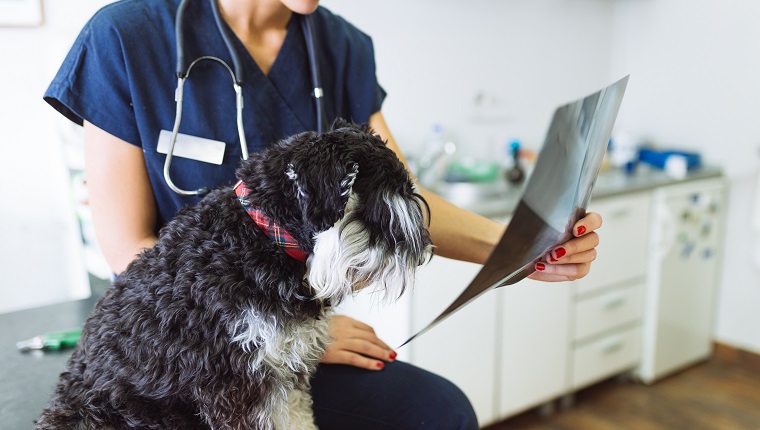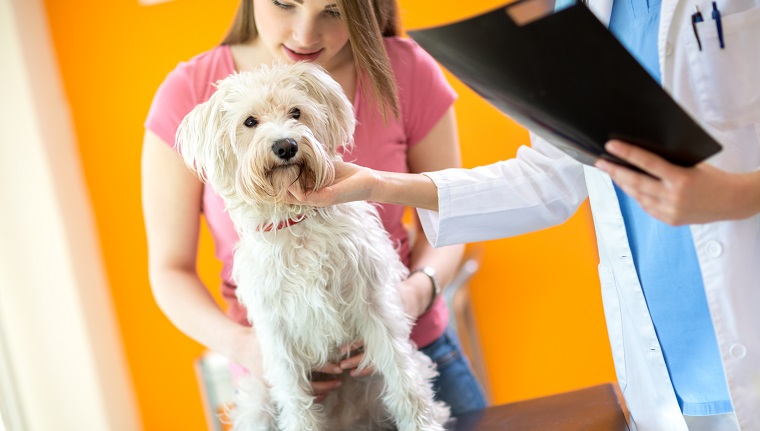Canine mammary tumors, or mammary neoplasms, are among the most common types of lesions found in female dogs. They arise from different types of tissues — epithelial or glandular tissues and mesenchymal or connective tissues — in the mammary gland.
Intact dogs are seven times more likely to develop mammary tumors than those who’ve undergone spaying or ovarihysterectomy — surgical removal of ovaries and uterus — before their first or second heat period.
Several spaniel breeds, Poodles, toy Dachshunds, and terriers are more prone to the disease. However, a recent study has revealed that smaller breeds have a relatively low incidence compared to their bigger counterparts.
If you suspect your dog has tumors or any type of canine cancer, then you must get to your veterinarian for a proper diagnosis and treatment. Here’s what you should know about the symptoms, causes, and treatments for mammary tumors in dogs.
Symptoms Of Mammary Tumors In Dogs
Mammary tumors in dogs can be small, simple nodules or large, aggressive, metastatic growths. The tumors can also occur in one or more glands.
Clinical signs include:
- Pain, ulceration, and inflammation in the overlying skin
- Fixation to the skin or underlying tissues
- Firmness
- Thickening
- Edema (abnormal accumulation of fluid)
- Erythema (redness)
In cases of advanced metastasis, the disease spreads to lymph nodes, lungs, colon, kidneys, liver, and sometimes bone.
Causes Of Mammary Tumors In Dogs

The development of mammary tumors in dogs is not well understood, but it is believed to be hormone-induced. Studies link the female reproductive hormone progesterone to the disease.
Spaying females before age two to two-and-a-half years old considerably reduces the risk of both benign and malignant tumors. But if they’re spayed after this period, chances of benign tumors are reduced; however, the possibility of malignant tumors remains alive.
Hormones do not have any direct mutagenic effect on mammary cells. Experts believe that cell growth induced by these hormones leads to malignant transformation.
In dogs who’ve been spayed early, the source of the hormones is eliminated, which puts these dividing cells at risk of mutation and malignant transformation by environmental carcinogens.
Therefore, administration of drugs that have a combined progestagenic-estrogenic activity increases the risk of malignant tumors. Growth hormone production induced by progestines leads to a rise in the blood levels of insulin-like growth factor that might lead to malignant tumors.
Other factors also include proteins like E-cadherin, connexins, and paxillin.
Veterinary Treatments
The diagnostic techniques for mammary tumors in dogs include thorough physical examination, routine hematologic and serum chemistry profile, urine analysis, chest X-ray, coagulogram, thoracic radiographs, caudal abdominal radiograph, and a rectal examination.
Vets also conduct fine needle aspiration with cytology (FNAC) in order to differentiate between benign and malignant tumors. It’s very important to find out which stage the disease is in before initiating any treatment.
Vets most commonly use surgery for treatment here. There are various types of them depending upon the size of the tumors, fixation to the surrounding tissue, and the number of lesions. These include:
- Lumpectomy or nodulectomy: Involves removal of benign superficial, non-fixed nodules. It’s a non-invasive method, and vets recommend it for localized tumors. It’s the most convenient method of breast conservation.
- Mammectomy: For patients with centrally developed lesions in one gland. If they’re too firm and fixed to the skin, the abdominal fascia is also removed along with the gland.
- Radical mastectomy: The breasts, the skin covering them, and the four lymph nodes are all removed at the same time.
- Bilateral mastectomy: Removal of both the breasts as a whole mass.
Vets have used chemotherapy, radiation therapy, and hormonal therapy to treat inoperable patients. Sometimes vets use radiation therapy intraoperatively and also post operatively to reduce the chances of recurrence.
New drugs and treatments for cancer are always in development. Your vet can provide you with the latest effective treatment options.
Many vets will spay a dog undergoing a mastectomy. She’ll benefit from the removal of the ovaries and uterus, which can minimize chances of camouflaging her tumors with a false pregnancy, as well as eliminating the chances of ovarian and uterine tumors.
Moreover, spaying will allow easy detection of any new tumors that may arise because the mammary tissue shrinks post surgery.
Prognosis
The chances of survival in case of mammary tumors depends on the size of the lesions. If they are less than three centimetres in size, then the prognosis is quite good.
But for tumors more than 1.5 inches in diameter, the chances of survival are bleak.
In the instances where it has metastasized to the lymph nodes, prognosis is very poor.
Have you spayed your dog to reduce their risk of developing mammary tumors? Do you keep up with vet visits to treat health problems early? Then let us know in the comments below!
Reference
Withrow and MacEwen’s Small Animal Clinical Oncology – Stephen J. Withrow, DVM, DACVIM (Oncology), Director, Animal Cancer Center Stuart Chair In Oncology, University Distinguished Professor, Colorado State University Fort Collins, Colorado; David M. Vail, DVM, DACVIM (Oncology), Professor of Oncology, Director of Clinical Research, School of Veterinary Medicine University of Wisconsin-Madison Madison, Wisconsin
This article is brought to you courtesy of the National Canine Cancer Foundation.









